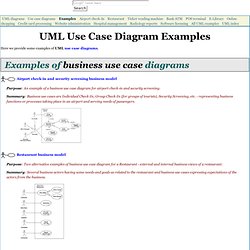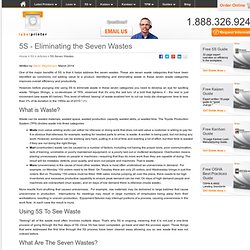Agile
> Michaelwarman
> BA Methodologies
Examples of UML Use Case diagrams - online shopping, retail website, bank ATM, e-Library, airport check-in, restaurant, hospital.
Here we provide some examples of UML use case diagrams.

Examples of business use case diagrams Airport check-in and security screening business model Purpose: An example of a business use case diagram for airport check-in and security screening. Summary: Business use cases are Individual Check-In, Group Check-In (for groups of tourists), Security Screening, etc. - representing business functions or processes taking place in an airport and serving needs of passengers. Restaurant business model Purpose: Two alternative examples of business use case diagram for a Restaurant - external and internal business views of a restaurant. Summary: Several business actors having some needs and goals as related to the restaurant and business use cases expressing expectations of the actors from the business. Examples of system use case diagrams Ticket vending machine Purpose: Show that ticket vending machine allows commuters to buy tickets.
Bank ATM UML use case diagrams examples Point of sales (POS) terminal. UI vs UX: what’s the difference?
UI is the saddle, the stirrups, and the reigns.

UX is the feeling you get being able to ride the horse, and rope your cattle. At least that’s what they used to say in the olden days. Rather, that is what I wished they’d say. Despite how simple that may have sounded, there are many complications and misconceptions when it comes to the differences between UI and UX design, and they cause the design community to go into quite a stir whenever they are brought up. An interesting note to that is that I’ve found the people who work at jobs with titles such as Interaction Designer to get paid more simply because they know and act on the differences between those two fields (typically harnessing a little of both).
Let’s jump right into a standardized definition that we will try to metaphorically elaborate on.
5S Eliminating the Seven Wastes. Written by Steve Stephenson March 2014 One of the major benefits of 5S is that it helps address the seven wastes.

These are seven waste categories that have been identified as commonly not adding value to a product. Identifying and eliminating waste in these seven waste categories improves overall efficiency and productivity. However, before plunging into using 5S to eliminate waste in these seven categories you need to develop an eye for spotting waste.
"Shigeo Shingo, a co-developer of TPS, observed that it's only the last turn of a bolt that tightens it - the rest is just movement (see waste #3 below). What is Waste? Waste can be wasted materials, wasted space, wasted production capacity, wasted skills, or wasted time. Muda (non-value-adding work) can either be idleness or doing work that does not add value a customer is willing to pay for. Mura results from anything that causes unevenness. Using 5S To See Waste "Seeing" all of the waste most often involves multiple steps. 2) Inventory. Kotter International - The 8-Step Process for Leading Change. Agile Use Cases in Four Steps. BABOK: Keeping up with the current trends of Agile Requirements Definition and Management (Agile transformation community)
#Agile #A Case Study: A Business Analyst on an Agile Project. Agile Use Cases in Four Steps. # Agile # scrum. -Adding Agile Practices to a Waterfall World: The Pre-Planning Session (Part 1)
The Scrum Title “Product Owner” must die! « On Product Management. Adding Agile Practices to a Waterfall World: The Pre-Planning Session (Part 1)
BABOK: Keeping up with the current trends of Agile Requirements Definition and Management (Agile transformation community)
A Case Study: A Business Analyst on an Agile Project. Cure Your Agile Planning and Analysis Blues: The Top 9 Pain Points. Agile-pack. Adding Agile Practices to a Waterfall World: The Pre-Planning Session (Part 1)



